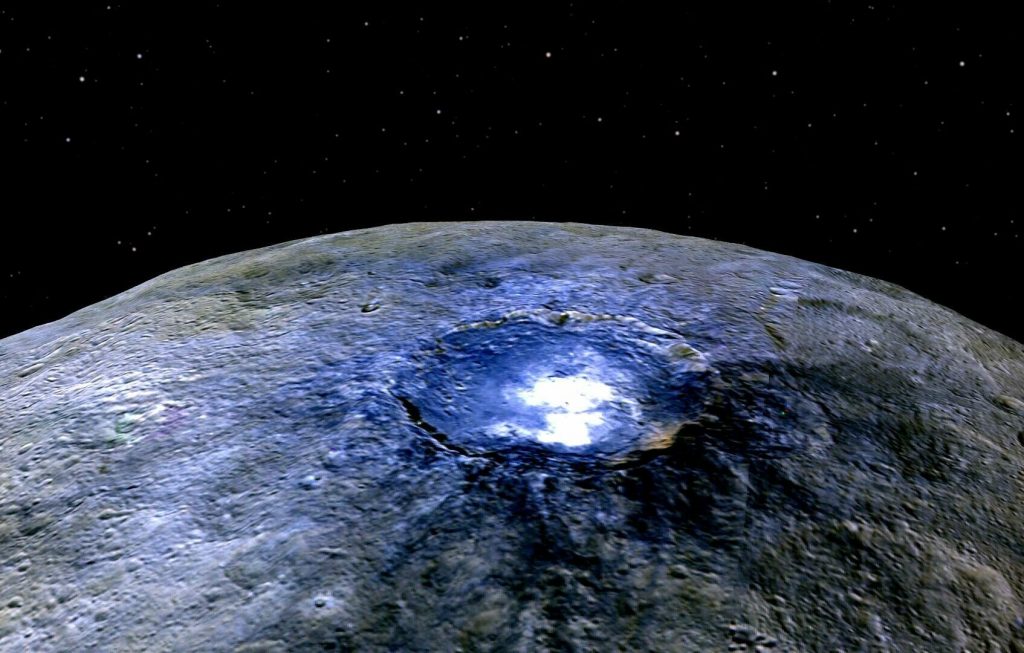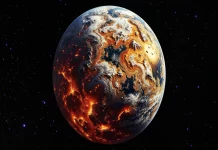
Deep within the murky recesses of the asteroid belt, there lies a mysterious dwarf planet with properties that has long fascinated astronomers.
A spacecraft orbited the planet for three years from 2015, and it transmitted data back to NASA that seemed to confirm what many had long thought existed in the planet’s core.

But what exactly is the asteroid belt, and where is it located?
It is an area between Mars and Jupiter which is filled with tens of thousands of large rocks known as asteroids.
For reference, they orbit the sun, as do planets.
Though the key difference is that they do not have the same mass as planets, which are shaped into a sphere by gravitational pull.

The particular planet in question is known as Ceres and it is the biggest object in the Jupiter-Mars asteroid belt.
This makes it the only dwarf planet in our inner solar system.
It was the very first denizen of the asteroid belt to be identified, and it was found by the Catholic priest and astronomer Giuseppe Piazzi way back in 1801.

Piazzi didn’t truly know what he had found when he discovered Ceres. After the astronomer first observed it in January 1801, he noted that it changed position the next time he saw it.
Piazzi’s first instinct was to classify it as a comet, but uncertainty led him to write to friend and fellow astronomer Barnaba Oriani.

“I have presented this star as a comet,” Piazzi said in his letter. “But owing to its lack of nebulosity, and to its motion being so slow and rather uniform, I feel in the heart that it could be something better than a comet, perhaps.”
The religious figure wrote to another astronomer called Johann Elert Bode, who subsequently concluded that the star was actually a planet.

Piazzi refused to share his data with other astronomers, though he did make sure to publicize his exciting finding to the press.
However, by spring 1801 no one except him had laid eyes on Ceres. Piazzi eventually published his data that July, and Ceres was finally spotted in the sky again six months later by the Hungarian astronomer Franz Xaver von Zach.

Interestingly, Ceres was initially designated an asteroid. But then scientists recategorized it as a dwarf planet in 2006, as it was so much bigger than comparable asteroids near it.
Indeed, Ceres makes up 25 percent of the mass of everything in the asteroid belt overall, according to NASA.

Despite being a large entity in the asteroid belt, however, Ceres is a much smaller fish in the larger solar system.
For instance, the space agency notes that it’s 14 times smaller than Pluto – the solar system’s smallest planet.
It added that if Earth were the size of a nickel coin, Ceres would be the relative size of a poppy seed.

According to NASA, it takes Ceres 1,682 days – or 4.6 years – to orbit the sun. It also rotates around its axis once every nine hours.
The tiny dwarf planet doesn’t have any rings or moons and it was named after the Roman goddess of harvests and crops. Interestingly, the word “cereal” is derived from the same source.

The agency writes that Ceres formed around 4.5 billion years ago when swirling dust and gas was pulled together by gravity.
For reference, scientists have called Ceres an “embryonic planet.” This means that it initially began to form into a fully fledged planet.
However, its progress was halted by the powerful gravity given off by neighbouring Jupiter, and it therefore didn’t reach its full potential.

The spacecraft which eventually orbited Ceres is known as Dawn, and it launched in September 2007. And the vessel’s journey was unprecedented; it would travel 4.3 billion miles over the course of 11 years.
Its mission was to investigate the processes that took place in the early evolution of our solar system. To that end, Dawn visited two celestial bodies – Vesta and Ceres.

When Dawn reached Vesta in 2011 it became the first ever spacecraft to orbit a body in the area between Mars and Jupiter. Then, when the vessel orbited Ceres in 2015, it became the first craft to visit a dwarf planet.
Dawn also made history as the first spacecraft to orbit two different bodies beyond Earth’s atmosphere.

Dawn was able to map craters on Vesta, and this data showed that the northern hemisphere of the asteroid had seen more large impacts than scientists had previously believed.
This likely meant that there were more big celestial bodies in the early days of the solar system’s evolution than once thought.

The data also suggested that planetesimals – the small bodies that later evolved into planets – started large and were struck by other things. This opposed the idea that they had been made of smaller rock formations that came together to form a larger whole.
As for Dawn’s findings on Ceres, they proved vitally important to scientists’ understanding of dwarf planets.

In 2018 data from Dawn was analyzed and researchers concluded that Ceres was a rich source of carbon. In fact, it had even more of it than other carbon-rich meteorites found on Earth.
Researchers already knew Ceres was rich in water sources and chemicals such as ammonium, so it gave the dwarf planet an odd chemical structure.

“Ceres is like a chemical factory,” said Simone Marchi, a Southwest Research Institute scientist who authored a research paper about the findings which was published in Nature Astronomy.
She continued, “Among inner solar system bodies, Ceres’ has a unique mineralogy, which appears to contain up to 20 percent carbon by mass in its nearest surface.”

“Our analysis shows that carbon-rich compounds are intimately mixed with products of rock-water interactions – such as clays,” explained Marchi.
“With these findings, Ceres has gained a pivotal role in assessing the origin, evolution and distribution of organic species across the inner solar system. One has to wonder about how this world may have driven organic chemistry pathways, and how these processes may have affected the make-up of larger planets like the Earth.”

Fast forward to August 2020 and an article encompassing seven different research papers was published in the British weekly scientific journal Nature.
Each paper had detailed new findings concerning Ceres, after new information had been gleaned by NASA from data transmitted by Dawn.
The findings had potentially huge implications for the theory that Ceres is a planet that could sustain some form of life.

Before it ran out of fuel, the Dawn spacecraft orbited directly above the Occator Crater – one of the oddest places in the solar system.
This huge impact site on the surface of Ceres is believed to be around 22 million years old, and it measures a massive 57 miles across, according to Space.com. It has also been seen to give off an eerie glow.

Arizona State University planetary scientist David Williams – who co-wrote four of the new research papers – explained how the researchers looked at Dawn’s findings.
He said, “We analyzed the final Dawn spacecraft data with every available tool in our toolbox; analyses of the shape of geologic features (geomorphology), topography of the surface, counting impact craters for age estimates, geological mapping [and so on].”

“We ended up with a final set of hypotheses to explain Occator’s bright spots,” continued Williams. “All of them involve the emplacement of a salt and carbonate-rich brine.”
NASA planetary scientist Julie Castillo-Rogez – who worked on one of the studies published in Nature – said, “Long believed to be a primitive body, Ceres is now an ocean world with deep brines at a regional and potentially global scale.”

“The 57-mile diameter Occator Crater turned out to be the ‘star’ in terms of geologically recent activity on dwarf planet Ceres,” said Williams.
“The bright materials observed in this 22-million-year-old impact crater appear to have erupted in the last two to nine million years, [thus] indicating there is some internal heat still left in Ceres.”

Water-based salts dehydrate within a few hundred years on Ceres’ surface. Intriguingly, though, Dawn’s readings showed that the salt deposits still contain water, so it must have only reached the surface comparatively recently.
This led researchers to posit the presence of liquid beneath Occator Crater – a reservoir that still transfers interior material to the surface.

One of the glowing areas within Occator Crater is known as Cerealia Facula, and a large deposit of salt was found there.
Dawn’s principle investigator Carol Raymond told Arizona State University in August 2020, “… The bulk of the salts were supplied from a slushy area just beneath the surface. [This was] was melted by the heat of the impact that formed the crater about 20 million years ago.”

Raymond continued, “The impact heat subsided after a few million years. However, the impact also created large fractures that could reach the deep, long-lived reservoir – allowing brine to continue percolating to the surface.”
Using gravity measurements, the scientists could map the density of Ceres’ so-called crust structure, and they found something interesting.

The density of Ceres’ crust gets more solid the deeper it goes. Therefore, the interior makeup of the dwarf planet is heavier than the scientists would have expected.
Their conclusion was that the internal reservoir of water at the heart of Ceres is freezing simultaneously with mud and salt solidifying in the lower end of the crust.

“All of the results suggest one or more brine reservoirs within the crust of Ceres – perhaps relics of an ancient ocean on this tiny world,” Williams told Arizona State University. “If it comes to fruition, a sample return mission would allow us to bring some of these bright materials to Earth to conclusively determine their origin.”

Earlier in Dawn’s mission, NASA’s scientists had analyzed the data it was receiving and concluded that saltwater was being brought to the surface of Ceres by geological activity of some kind.
But the new data caused them to reconsider this theory. In fact, they now believed Ceres’ surface may have been active far more recently than 22 million years ago when the crater formed.

O
ne of the new research papers posited a timeline of geological events at the Occator Crater.
It theorized that cryovolcanism began nine million years ago and it took place over the course of several million years.
It led to the forming of several bright deposits, caused by brine oozing outward from Ceres’ mantle and through the surface’s upper layer of rock.

This paper theorized that the volcanic activity may have even been occurring as recently as one million years ago. It also stated that the volcanism on Ceres is different from any other kind in the solar system.
This is because it is taking place on a small dwarf planet that doesn’t face the same kind of gravitational pull as, for example, Jupiter’s moon Io.

Another research paper identified a specific kind of salt found on Ceres which had previously only been found on earth.
The researchers posited that the brine which deposited the salt on the surface of Ceres had done so comparatively recently.
In fact, the brine and salt deposits may continue to this very day.

This kind of salt may also be the answer to what exactly is keeping the dwarf planet warm – despite it having no gravitational tugging. It could even be the reason why there are liquid pockets within the makeup of the planetoid.
This paper also suggested that the initial impact that caused the Occator Crater might have heated the asteroid enough to trigger the brine oozing. As a result, this then led to the bright deposits on the surface.

Overall, the findings certainly seemed to lend credence to the idea of Ceres being a planet capable of supporting life.
In 2016 Trieste Astronomical Observatory astronomer Paolo Molaro and his team were analyzing the bright spots on Ceres. And he spoke to Astrowatch about the potential for life existing on the planet based on what they knew then.

Molaro said, “Life – as we know it on Earth – needs liquid water, biogenic elements, and a stable source of energy. Is Ceres a good place to have these things simultaneously and for a substantial amount of time – like billions of years? Nobody knows at the moment.”
However, a slightly more educated opinion can be espoused following these recent discoveries.

Macquarie University planetary scientist Craig O’Neill was extremely optimistic about life existing on Ceres. In fact, he didn’t see any reason that a living organism hadn’t already been found.
He told ABC Science in August 2020, “I am sure that someone’s found a lifeform – a little archaea bug living in a deep ocean vent or something – that could live under these conditions.”

“It’s almost certain that something out there could handle the conditions in the interior of Ceres, which means when we’re thinking of things like habitability,” continued O’Neill.
“We have to expand the scope of potential environments in the solar system that are habitable – all over again.” NASA’s Carol Raymond wasn’t quite so positive, however.

Raymond did believe that there may have been a point in its history when Ceres was habitable.
In the past, it was hotter, the internal ocean was thicker and there were chemical reactions taking place all over the planet.
She told ABC Science, “But it’s unlikely that that persisted over sufficient time to allow the emergence of life.”

If life ever did exist on Ceres, Raymond believed it wouldn’t have been native to the planet. Rather, it would have been some kind of hitchhiker – such as an extremophile bacterium.
After all, this would be the only living thing capable of surviving in conditions inhospitable to carbon-based lifeforms.

For her part, University of Canterbury astrophysicist Michele Bannister felt the data was hugely meaningful. She told ABC Science, “If you have salty liquid moving around in the upper layers of this object in the present day, that is something we do not yet have proof of in the Martian surface. It could be that this is the closest-to-Earth environment of that sort in the solar system.”

Overall, the scientific community was ecstatic with Dawn’s performance. NASA Jet Propulsion Laboratory mission director Marc Rayman told Arizona State University, “[The spacecraft] accomplished far more than we hoped when it embarked on its extraordinary extra-terrestrial expedition.” These exciting new discoveries from the end of its long and productive mission are a wonderful tribute to this remarkable interplanetary explorer.”
Discover more at Historical Post













Perhaps we can send traitors there? We clearly don’t need them breeding baby bolsheviks here, do we?